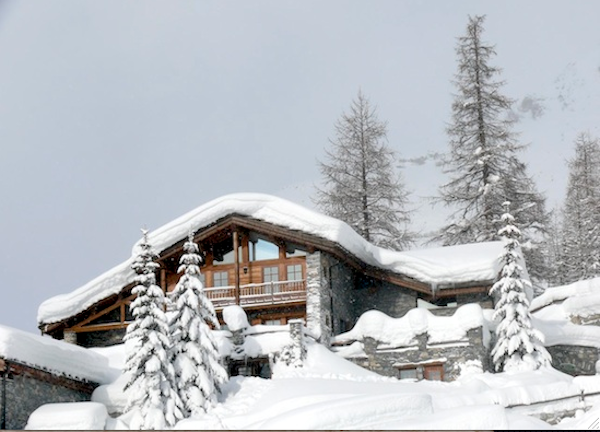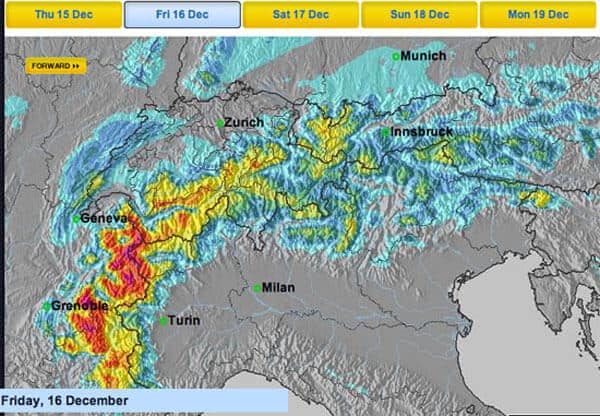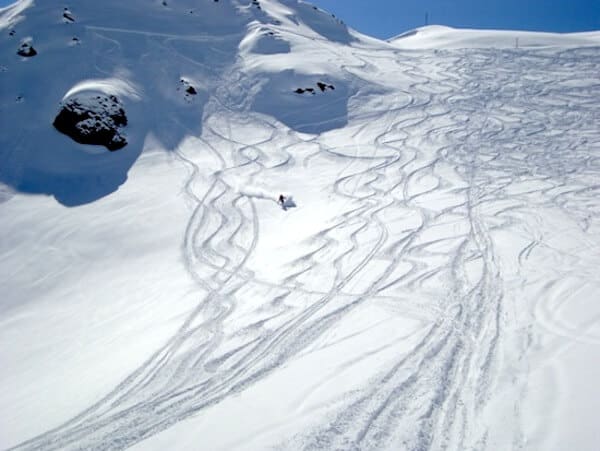
No two winters are ever the same – and there can be few better illustrations of that fact than the ski seasons of 2010-11 and 2011-12. Snow-wise, 2010-11 was a slow-motion disaster for the northern Alps; while most of western Canada and North America had a spectacular season. Contrast that with 2011-12. For the first half of winter, the northern Alps were blasted by snowstorm after snowstorm – and buried beneath a thick blanket of white. Meanwhile, in the American Rockies, some resorts endured their worst drought for 30 years.
But if you think it was an Alpine ski resort which had the most snow last winter – well, sorry, you’ll have to think again.
What was also striking about the winter of 2011-12 was that few people expected it to turn the way it did. Parts of the Alps had their warmest and driest autumn on record, and when early-season skiers travelled out to the glaciers in November, there were some pretty bleak pictures flying about. Of course, everyone tried to keep calm. But those last weeks of the autumn were a white-knuckle ride.


And then, over the weekend of December 3 and 4, the weather broke. There was only a dusting of white at first, and it was pretty warm at lower altitudes, with rain falling instead of snow. But then it dumped. And dumped. And dumped. A succession of powerful Atlantic storms slammed into the north-western Alps and delivered massive snowfalls to many areas. Most affected was the French Tarentaise, where Val d’Isere saw over 4 metres of snow in December alone – nearly twice what it received in the whole of 2010-11! Much of Switzerland and western Austria (especially the Arlberg) also benefited, but Italy and the Southern Alps largely missed out. Here, many resorts (especially those in the Dolomites) relied heavily on artificial help to see them through the festive period.
Frequent, heavy snowfalls continued to affect the northern Alps throughout January. The Swiss resorts of Crans Montana and Arosa both clocked 3.4m of the white stuff – their single snowiest months in recent memory – and Austrian resorts also got a pasting, with several resorts cut off in the west, and settled snow depths above St Anton creeping up to very nearly six metres. On January 9, resorts in the Tirol were already reporting the snowiest January for 30 years.
Of course, powder hounds rejoiced. But these were also tense times in the mountains. On the night of January 5/6 in Val d’Isere a 201km/h gust of wind was recorded up on the Rocher de Bellevarde. The avalanche risk hit 5/5 and bars and restaurants shut early, to keep the public off the streets. Meanwhile, in Austria, Dr Rudi Mair, head of the Tirol’s Avalanche Warning Service, told Welove2ski on January 9 that “if we were expecting half a metre to a metre more snow this week then perhaps villages as well as roads would be under threat.” Fortunately, the skies cleared just in time – allowing helicopters to inspect the snowpack and drop explosive charges. No mass evacuations were necessary.


But whilst snow depths approached record levels at altitude, fluctuating temperatures (and some rain) meant cover was less exceptional lower down. Some snow did get through to the Southern Alps, mostly in the West (for example, in Cervinia and Courmayeur) but the Dolomites (Selva, Cortina) and the southern tip of the French Alps (Isola 2000) both continued to rely heavily on man-made snow.
February saw less snow but produced one of the coldest snaps the Alps has ever known. In Tignes the temperature plummeted to -30°c, a new record at resort level, and a bitter east wind rendered exposed slopes virtually un-skiable. Meanwhile, in Austria, there was one more meaty January-style storm, which saw Lech and Zurs cut off (again) – and a number of grim avalanche accidents, including the one that buried Dutch prince Johan Friso.
Meanwhile, in the Southern Alps the snow drought continued, but at least the cannons were now operating at full tilt, whilst further north, frigid temperatures kept the massive snow pack in mint condition.
Then, on February 22, the temperature in the Alps suddenly jumped – heralding another twist in this winter’s extraordinary weather.
March was exceptionally warm and exceptionally dry – triggering big avalanches on sunny slopes as the snowpack suddenly heated up. (The most famous was the one at St Francois Longchamp, above, which took out a chair-lift.) Indeed, many resorts couldn’t count a single new flake of snow and conditions in the Southern Alps deteriorated at an alarming rate. Had it not been for the bumper early season snowfalls, other regions might also have been in trouble, but in the event most resorts held up well.

Just as many resorts were winding down for the season, April brought another massive change in the weather. Out went the unbroken sunshine and balmy spring temperatures and back came winter. There were regular snowfalls throughout the month, particularly at altitude, with Arc 2000 seeing 1.55m of new snow.
So who got the most snow overall? Well it certainly wasn’t the Dolomites, which endured a particularly lean winter. Arabba (1600m), whose modest seasonal average is 3.8m, could only manage 1.9m this time around. Further west, things were a little better but 3.8m for high altitude Cervinia is still way below par – as is 5.5m for Plateau Rosa (3400m).
The snowiest resort in France for the past three years, Isola 2000, this year only managed just 2.9m some 50% below average. Further north, Val d’Isere impressed with 6.9m (average 5.2m) but this fell short of the 8.6m that fell in France’s snowiest resort – Avoriaz – which saw over 10m at altitude. In Switzerland, Zermatt clocked 3.6m – not much on the face of it, but still a little above average for this rather dry corner of the Alps. Andermatt (1450m) saw 6.6m at village level and over 9m at the Gemsstock mid-station (2200m), but snowiest of all Swiss resorts was Arosa (1800m) with 8.8m – at least 2m above its long term winter average. High Austrian resorts were also very snowy, with 9m for Lech (average 7.1m) and 10.2m at Galzig (2185m) above St Anton. Nearby Warth-Schroecken had more still with 11.1m but, for once, was not Europe’s snowiest spot. This year, that title belongs to…Obertauern with a massive 12.2m.

With a few notable exceptions North America had a season to forget. Western Canada and the Pacific north-west saw plenty of early snow – as did Arizona and the far south-west of Colorado – but most big name resorts including Mammoth and Vail fell well below par and were only partially open for the festive period. Things didn’t improve much in January, either, and it was well into February before most Colorado resorts were even close to fully operational. For a short while thereafter there was some decent skiing on offer, but most of March was again dry and most resorts ended up with their worst snowfall for 30 years. Vail clocked 5.4m (average 9.2m) Snowbird 7m (average 12m) and Mammoth5.7m (average 9.3m).
There were no such problems for the north-west, however, and after a monster March, Lake Louise broke its all-time seasonal snowfall record with 7.1m, some 70% above average. Whistler also had a memorable season with 13.8m at its “Roundhouse” measuring station (average 10.6m). However, neither comes anywhere close to claiming this year’s crown. Because…(drumroll)…this year’s North-American winner was Mount Baker: with a whopping 20.4m. That’s well up on its mighty 16.4m average: but short of the 29m world record set in 1999.















Who got the most #snow 2011-12? Read my review of the #ski season
https://t.co/ia4npxth
RT @FraserWilkin: Who got the most #snow 2011-12? Read my review of the #ski season
https://t.co/ia4npxth
RT @FraserWilkin: Who got the most #snow 2011-12? Read my review of the #ski season
https://t.co/ia4npxth
RT @welove2ski: Who had the Most Snow Last Winter? https://t.co/SFa04Hbb
We had “a little” in Verbier too https://t.co/YFPyQmp7 RT @welove2ski: Who had the Most Snow Last Winter? https://t.co/h1t6h3f2
Great article guys!
RT @welove2ski: Who had the Most Snow Last Winter? https://t.co/bO3UbpV5
RT @SkiCoupons: RT @welove2ski: Who had the Most Snow Last Winter? https://t.co/bO3UbpV5
Nice! but lots or little, I’m going anyway : ) “@SkiCoupons: RT @welove2ski: Who had the Most Snow Last Winter? https://t.co/nknForEc”
Teena Freeman liked this on Facebook.
Avoriaz was the snowiest resort last winter for snow with 10 meters! Read half way down the report – Thanks Amie… https://t.co/APJGmhyy
RT @welove2ski: Who had the Most Snow Last Winter? https://t.co/7KlGe9jQ
Welove2ski has worked out which resort had the most snow last year – Val d’Isere was up there https://t.co/esX7j7VH
Kim Battoe liked this on Facebook.